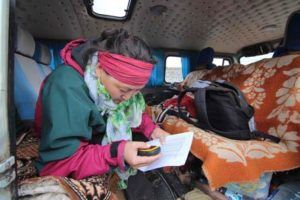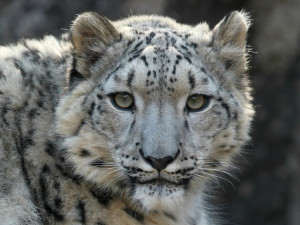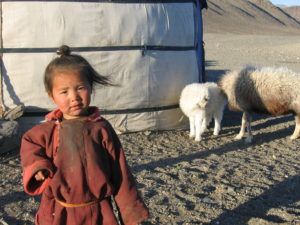In this guest blog post Bayara Agvaantseren gives us an insight into what it’s like working to protect snow leopards, and describes the strides being made with local communities and the Mongolian government around the newly formed Tost Nature Reserve.
Mongolia is home to the second largest snow leopard population in the world, but sadly their numbers continue to plummet. Like many big cats, they are persecuted in retaliation for killing livestock and hunted for their fur as their home territory is becoming increasingly shared with humans.
Saving snow leopards in Mongolia: new nature reserve takes major steps forward
By Bayarjargal (Bayara) Agvaantseren, Director, Snow Leopard Conservation Foundation (SLCF)

This summer I traveled from our headquarters in the capital of Mongolia, Ulaanbaatar, to some of the furthest and most remote reaches of snow leopard habitat—the Tost Mountains in Mongolia’s South Gobi Desert. The trip, a 16-hour van ride through the Gobi Desert, feels like being spun and bounced around in a washing machine as usual.
I traveled to Tost because it is not only the heart of some of the richest and most important snow leopard habitat in the world, but also the site of one of the most amazing developments in the history of snow leopard conservation. After seven years of intense grassroots mobilization and advocacy, in 2016 Tost was declared Mongolia’s first state Protected Area for snow leopards. This has changed the fate of snow leopards in South Gobi. Before, the land across Tost was unprotected and blanketed in mining licenses. Now we have a chance to save this critical habitat.
But now that Tost is an official Protected Area—called the Tost Nature Reserve—the work doesn’t stop. In fact, it’s more important than ever that we continue so that Tost can become a functional and meaningful Protected Area.
We want to have rangers on the ground making sure snow leopards and prey are safe from hunting and poaching. We want mining companies and government to uphold Protected Area boundaries. But all these things take coordination, and it’s not easy to get everyone working in the same direction at the same time. Mongolia’s federal Government is providing tremendous support, but has very little money to make all this happen. They are relying on us for leadership—and that is where PTES has been truly a life-saver.

In the last few months, thanks to PTES, we’ve been able to make significant gains. In May 2018 we held a large workshop in Tost for 28 key stakeholders. Leading the workshop was, snow leopard expert, Dr. Koustubh Sharma, Senior Regional Ecologist with the International Snow Leopard Trust. Dr. Sharma shared the key locations of snow leopard, ibex and argali in Tost Nature Reserve, and then we overlaid maps of natural resou
rce areas such as water oases. Ultimately we determined which areas of Tost need special protection and limited use by livestock and tourism, and which areas where these activities will have less impact on wildlife. We now have a plan for how to prioritize wildlife management within Tost, which is fantastic
After months of urging, in August we finally received confirmation that the district government has designated one space specifically for the centralized administration of the new Tost Nature Reserve. This is also a huge step forward: it shows government commitment towards the management of Tost Nature Reserve, it provides a centralized place to organize and focus rangers, and it is a great area for sharing resources and information about Tost.
Finally, with support from PTES, this summer we completed training for seven local ‘citizen’ rangers so they can begin patrolling Tost Nature Reserve, and support the federal rangers once official staff are hired for Tost Nature Reserve. The citizen rangers now have the skills they need for managing and sharing their data, and adding their findings to a centralized monitoring system–which will help everyone working in Tost.

The Tost Mountains themselves are home to at least 12-14 adult snow leopards, and many more cubs and itinerant cats. Today, we know Tost is an important corridor linking two other national parks. Tost Nature Reserve and the adjoining national parks create one of the largest, contiguous protected landscapes for snow leopards in the world. It is also the first-ever example of a successful community-managed Protected Area for snow leopards and, as such, sets an important precedent for other community-led conservation efforts across the cat’s range. These milestones would not have been possible without PTES, and this summer PTES made great strides towards building even stronger government and community collaboration. We are very grateful to PTES for making this important work possible to save Mongolia’s snow leopards.
_____________________
Snow leopard conservation in Tost Nature Reserve, Mongolia is led by Snow Leopard Conservation Foundation in partnership with the local Tost community and Tost government. It is funded by the People’s Trust for Endangered Species.
